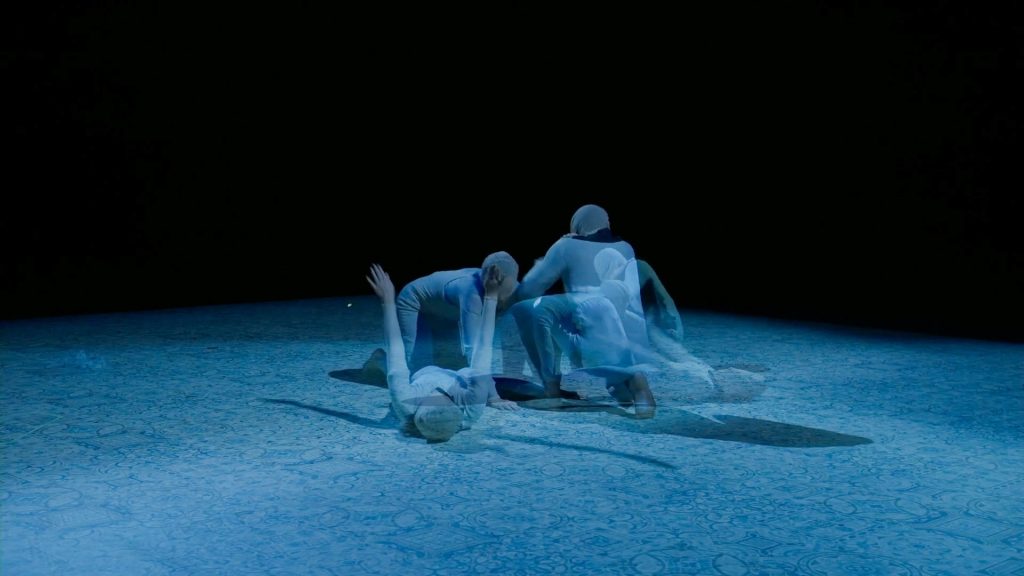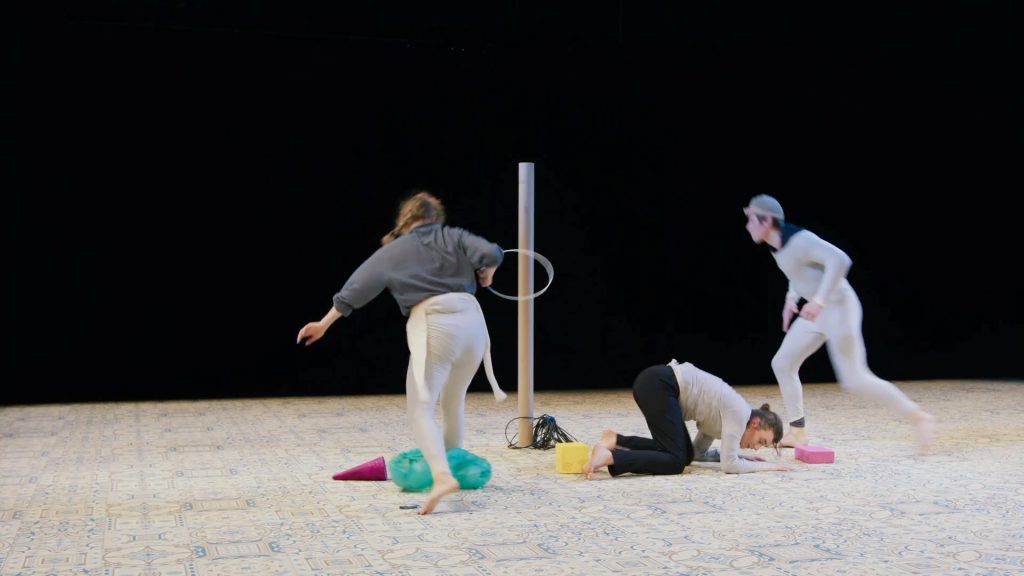TANZPLATTFORM 2022 >>> In “Telling Stories – a version for three” by Fabrice Mazliah / Work of Act, playing 17 – 19 March at Radialsystem, as part of Tanzplattform 2022, three dancers play with invisible objects that their imaginations, joined with those of the audience, make real.
As I was choosing my seat, performers Katja Cheraneva, Susanne Grau, and Tilman O’Donnell were already in motion. They moved with effort and precision, perhaps as if interacting with invisible, imagined physical features and objects around them, or as though they were restricted by these objects. It felt like walking into a dressing room in the minutes before places are called, watching everyone doing up their buttons and straightening their wigs, settling into their parameters for the coming show.
The house lights fell and the three performers continued to move, but now, at the same time they were playing a game of questions. The questions were about tables. They asked one another table-questions ranging from the practical (“Katja, what shape do you prefer in a table?”), to the emotional (“What sorts of tables do you trust, Susanne?”), to the speculative (“Tilman, what do you think the future holds for tables?”). My favorite speculation — that putting a wooden table in a forest might make the trees paranoid — was also my first hint that this performance was much more about what people project onto objects than about the objects themselves.
I couldn’t help but see the question game as a riff on similar games played in an improv comedy context, and this association was strengthened when the performers began to interrupt their movements and musings with cries of “Freeze!”. The one who had called the freeze would then describe the tableau in which the other two performers had been suspended, as if describing a static, realistic image. “Here’s Jean doing yoga with his partner in 1992 just before his heart attack.” or “Here’s a drawing by a child — we think this is his turtle, and this figure here is the child himself.”
Throughout, the performers seemed to navigate trajectories of movement, thought, and speech that were separate from one another. Not parallel, though. Where parallel lines, by definition, never touch, the trajectories in question here were punctuated by crucial points of intersection. The conceptual table, erected out of questions, acted as one such point of intersection. As the performers turned the idea of a table around and around in their minds through questions, it was almost as if a material table flickered in and out of reality. They asked all of us in the theatre to interact with the same idea, ‘table’, rather than a particular arrangement of materials. By focussing on the idea of a table in general, rather than interacting with one specific instance of a piece of furniture, and by not defining ‘table’, but rather allowing their musings and gestures to interact nonlinearly with the mental pictures that must have arisen in all of our minds as we watched, the performers invoked something like the Platonic ideal of a table.
The action shifted to a repeating group choreography that reminded me of yet another improv game in which the players build a fantastical machine with their bodies. But it slowly became clear that this was a choreography from which everything but the dancers had been subtracted — and then began to be added back in. Material manifestations of the objects that were at first physically absent, but that Cheranava or Grau or O’Donnell had evoked through their words and collective movement, entered into the repetitions. Now a physical bag was brought onstage and when it took its place in the choreography it became clear in retrospect that a gesture Cheranava had repeated several times already had actually been a pantomime of tossing the bag’s strap over her shoulder. Similar revelations happened with the entrance of some bubble wrap, a ring of keys, and, of course, a table. There was an odd mixed satisfaction and letdown to this fantasy fulfillment, like watching a movie based on your favourite book. But the fantasy evolved, as the choreography kept repeating and the objects that had taken up their places in the moving picture were replaced by other objects that filled the same spaces, but less literally. The role of the keys that one dancer tosses to another was no longer played by keys, but instead by an orange ribbon that unfurled as it was tossed. A tall, wobbly cardboard tube was cast as the coat rack. House slippers were represented by a crinkly bag on Grau’s foot.
I experienced “Telling Stories – a version for three” as less an exploration of objects in themselves, than of human projections that solidify into objects — how humans shape stuff that also shapes us. The things in the space, first imagined, then real, then ‘performed’ by other things, became witnesses to the tender, myopic absurdity of the human gaze. If a table sits in a forest and no-one (human) is there to see it, what do the trees feel?
Pictures: “Telling Stories – a version for three” by Fabrice Mazliah / Work of Act ©Work of Act (left photo), Jörg Baumann (right photo).
“Telling Stories – a version for three” by Fabrice Mazliah / Work of Act was presented by HAU Hebbel am Ufer in the frame of Tanzplattform Deutschland 2022 in Berlin from 17 to 19 March at Radialsystem.
Conceived & Choreographed by Fabrice Mazliah / Performed by Katja Cheraneva, Susanne Grau, Tilman O’Donnell / Dramaturgical assistance: May Zarhy / Sound composition by Johannes Helberger | kling klang klong / Light concept: Harry Schulz & Matthias Rieker / Technical Direction: Matthias Rieker / Costumes: Anne-Marie Miene / Production management: Johanna Milz






